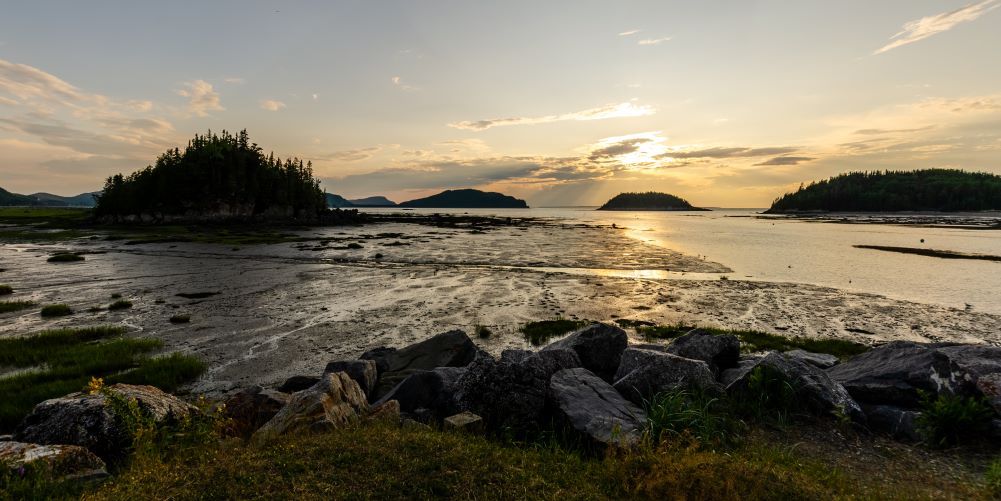A guide to the different îles du Bic
Located off the coast of the bay that bears the same name, the îles du Bic are home to a number of well-kept secrets. Each island has its own unique history and wildlife, attracting many curious tourists every year.
Île du Bic, Île Bicquette, Île du Massacre, Île aux Amours and Île Brûlée: Visiting these islands is an absolute must during your Rimouski trip.
Le Vieux Loup de Mer will tell you everything you need to know about these extraordinary destinations.
ÎLE DU BIC AND ÎLE BICQUETTE
The Île du Bic is the largest island in the bay, covering an area of 14 km². This uninhabited island is home to diverse wildlife.Off the coast of Île du Bic, you’ll find Île Bicquette, an island that measures only a few hundred metres long.
These islands are part of the Estuary Islands National Wildlife Area, a protected area that includes many islands in the St. Lawrence Estuary, particularly famous for the observation of the whales which are there.
A RICH HISTORY
In colonial times, the Île du Bic served as a landmark for navigators exploring the St. Lawrence River. The French settled on the island in the 17th century. The island was an important communication base between the various outposts in the region and came to play a large role in the Anglo-French War.
In the 19th-century, some explorers built houses on Île du Bic. The harsh waters surrounding the island were the site of numerous shipwrecks—nearly 20 wrecks in all.
Despite its rich contributions to Le Bic’s history, the island is currently entirely uninhabited…except for the scores of seals!
DIVERSE FLORA AND FAUNA
The Île du Bic is almost entirely flat. It’s composed of numerous rocks called schists and is crisscrossed by small lakes and streams, forming coves.
The maritime atmosphere of Île du Bic does not leave @dj. stella indifferent!
Its rich geography makes Île du Bic the perfect home for a wide range of animals. You can find many seals lurking about, as well as a number of birds and small mammals similar to the animals in the Parc National du Bic.
ÎLE BICQUETTE
Also known as Îlot du Bicquet, this little island is located off the coast of the much larger Île du Bic. In 1844, a lighthouse was built on the island to guide navigators around its hostile, rocky shore. Several cannons were also set up to protect the island.
Like the Île du Bic, the Île Bicquette was the site of numerous conflicts and shipwrecks. Today, the island is closed to all visitors without prior authorization, in order to protect its wildlife.
And boy does this island have wildlife! More than 12,000 common eiders come to the island each year for breeding season. Not to mention the other birds, seals, fish and small mammals that call Île Bicquette home.
THE ISLANDS OF PARC NATIONAL DU BIC
Near Parc national du Bic and Havre du Bic (Bic Harbour), you’ll find the three small islands: Île aux Amours, Île Brûlée and Île du Massacre. Visible from the coast, each island has its own unique history and landscape.
Did you know? You can also spot these islands from some of our cottages, like Le Chasse-Marée! 😊
ÎLE AUX AMOURS
Located in the middle of Havre du Bic, the Île aux Amours has a rich indigenous history. An indigenous family settled on the island in as early as 1550. Much later, in the 1950s, an inn was built on the island. Île aux Amours is shrouded in mystery and legend, making it hard to unravel the truth behind its name.
Legend has it that the many couples who came to stay at the inn would stroll hand in hand along the coastline, earning it the name “l’Île aux Amours” (Lovers’ Island).
Did you know? : The natives who populated the area were the firsts to practice ice fishing! 😊
The Island is a perfect setting for romantic walks, don’t you think? @christian_ducharme illustrates this romanticism!
You can reach the Île aux Amours by kayak or by foot at low tide from the Parc national du Bic. Set aside an hour to explore the hiking trails on the island.
ÎLE DU MASSACRE
Known for its tragic history, the Île du Massacre is named after the. Mi’kmaq Massacre.
According to Jacques Cartier himself, in 1533, some fifty families from the nomadic Mi’kmaq tribe ventured into what is now the Parc national du Bic to find food. There they encountered the Iroquois, who then chased the Mi’kmaq to Île du Massacre, where they took refuge. The Iroquois found the Mi’kmaq hiding in a cave and massacred them, women and children included. Of the nearly 200 Mi’kmaq on the island, only 5 managed to escape the massacre.
The truth behind this story is still contested today. Some question the numbers, others debate whether the Mi’kmaq were ill-intentioned. There’s even claims that the massacre actually took place on Îsle-Verte.
Nowadays Île du Massacre is uninhabited. You can reach it by foot at low tide, and it’s possible to walk the length of the island.
ÎLE BRÛLÉE
The Île Brûlée is located just beyond the Île du Massacre, a little further offshore. It is said to take its name (“Burnt Island”) from a fire that ravaged it long ago. The island has since been restored to its former glory, however. Today, you can explore the wild and dense vegetation that it’s known for.
You can reach the Île Brûlée by sea kayak and soak in its stunning sunsets over the bay!
REST UP FOR YOUR ÎLES DU BIC ADVENTURE AT LE VIEUX LOUP DE MER!
The Îles du Bic are full of history, legend and wildlife—making them one of our top places to visit in Rimouski! Whether you’re exploring them in a sea kayak or on foot, you won’t soon forget your trip.
Your own tale of adventure starts at Le Vieux Loup de Mer! Our holiday cottages in Bic are the perfect home base for your island exploring. You can even spot the Îles du Bic from some of the cottages! Contact us today! The Vieux Loup de Mer team will let you in on some of our very own Bic secrets and stories 😉


